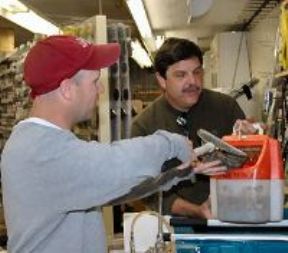VHS - wild bait harvest information
Fishing Wisconsin
Beginning in May 2007, in response to the possible threat posed by moving VHS-infected wild baitfish, the DNR required that licensed bait dealers harvesting wild bait in Wisconsin apply for a free permit indicating the location and targeted species that they would be collecting from state waters. These bait dealers are also required to keep records of what they harvested and where it was sold. The requirements have enabled DNR to learn a lot more about wild bait harvest in Wisconsin.
Closure of all VHS known and suspect waters to wild bait harvest
In order to allow the movement of minnows by anglers in the limited cases that were approved, further restrictions must be placed on the harvest of live minnows. The new rules passed recently prohibit the harvest of wild minnows, both commercially and for personal use, from all VHS known and suspect waters. It is now illegal to possess or use minnow harvesting gear on any of the VHS waters. The reason for this restriction is to prevent the movement of likely infected bait minnows which could then infect other waters in the state.
Wild bait harvest status
Rules put into effect have many implications on the harvest of wild bait. Conditions on the New Combined Bait Harvest and Nonstandard Minnow Gear Application and Permit require that VHS susceptible minnow species harvested from the wild must be inspected by a qualified fish expert and receive a Fish Health Certification (FHC) before they can be distributed. Minnow species identified by APHIS as susceptible to VHS includes but are not limited to: emerald shiners, bluntnose minnows, and spottail shiners.
New permits
New wild bait harvest permits are now in effect. A copy of these new permits along with a letter explaining the changes was recently sent out to all licensed bait dealers. These new permits are a result of the November 2007 DNR emergency VHS rule and contain conditions requiring the disinfection of harvesting equipment before moving to another waterbody and inspection of all harvested bait. Please carefully read all conditions of the permit. New permits will be valid for 30 days, thus reducing the amount of paperwork. Permits can be submitted no more than 30 days before their requested start date. There are also more specific criteria for identifying targeted species to help control the spread of VHS.
Required inspection of all harvested minnows
All VHS-susceptible minnow species harvested under a wild bait harvest permit MUST be inspected by a qualified fish expert [exit DNR] and issued a Fish Health Certification (FHC) before they can be used or distributed. Each species harvested must be tested separately and that FHC applies only to the group of fish actually inspected – not the waters from which they came. FHCs are good for 30 days.
The fish health expert is then required to send a legible copy of the completed certificate to DATCP and the bait harvester is required to send a copy of the certificate to the DNR at:
Fish Health Certificates FH/4
PO BOX 7921
MADISON WI 53707-7921
The bait harvester is also required to keep a copy of the certificate for 5 years after the date the certificate is issued. The harvester is not required to but may choose to provide a copy of the certificate to the bait retailers where the bait is sold.
Identifying your catch
We are providing identification keys to help with distinctions between species of minnows that look similar, comparing photos and physical characteristics. If you need help distinguishing a fathead minnow from a bluntnose minnow, check out the following guidance information:
Crayfish
The invasive rusty crayfish can be collected for use as food or as bait and moved live as long as they are in a container from which they can't escape and all water is removed from the container.
With the new rule changes enacted this fall, there are also changes to the rules pertaining to crayfish harvest. The most significant change is that the rule concerning crayfish bait has been rewritten.
- It is now LEGAL to use meat other than fish for bait. This includes, but is not limited to, chicken and beef livers, chicken necks and other meats.
- If fish or fish parts are to be used for bait, they must come from the same waterbody where you intend to use them as bait or have been bought from a Wisconsin bait dealer. Commercially processed fish may be used as bait. For your convenience, here is the letter detailing and authorizing the use of commercially produced baits.
- In addition, the new rules prohibit the movement of water and live fish from any waters. To be legal and aid in the effort to control the spread of VHS, all water must be drained from escape-proof containers holding live crayfish before transporting the container away from the bank or shore of any waterbody. Well or tap water may be added back to the container to keep your crayfish live after away from the water, bank or shore.
The rest of the rules that were in place still apply; please consult the regulations for more information.


